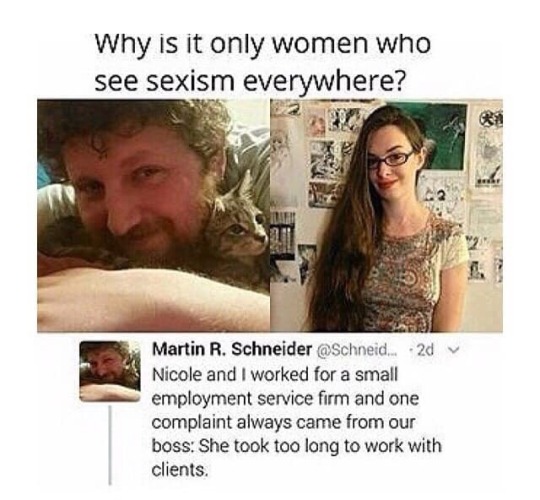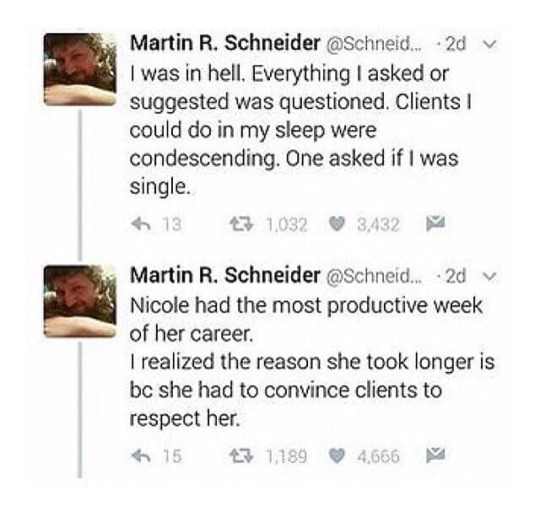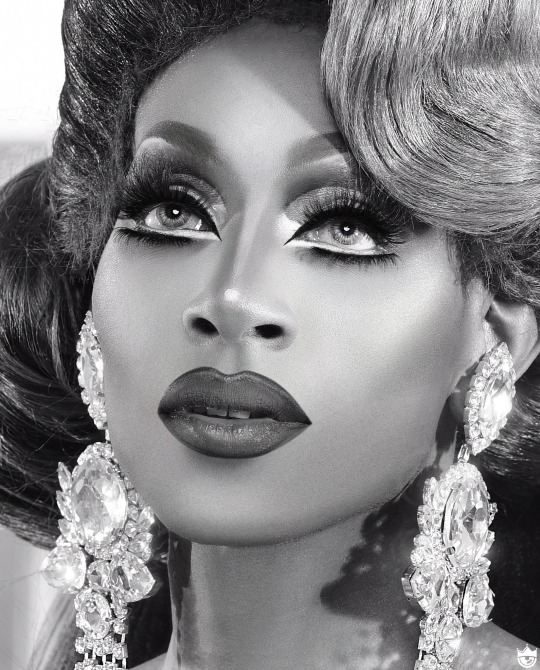Photo
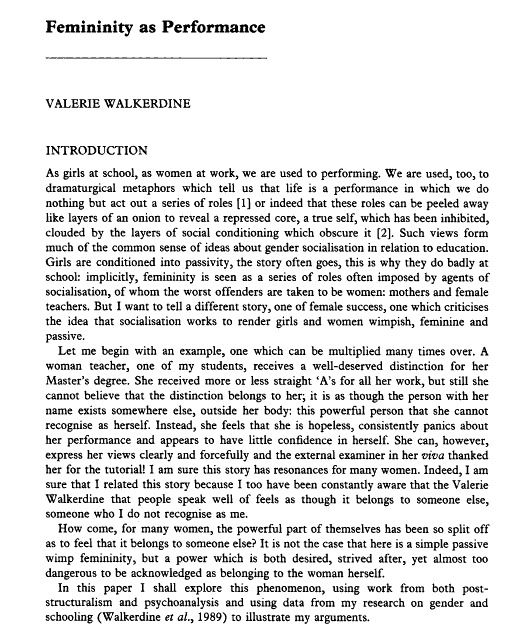
Valerie WalkerdineOxford Review of EducationVol. 15, No. 3, Gender and Education: Current Issues (1989), pp. 267-279
0 notes
Text

excerpt from ‘A Trans Body’s Path in Eight Folds’ from Pass with Care: Memoirs by Cooper Lee Bombardier (2020)
8K notes
·
View notes
Link
(Head to the link above for bigger versions of these photos!)
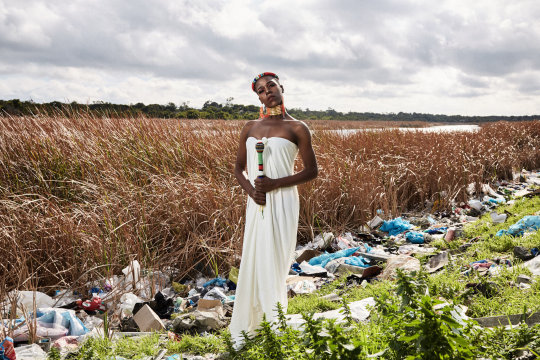
^Belinda Qaqamba Ka-Fassie, a post-graduate student in education at Stellenbosch University, wears a dress that resembles the white blanket typically worn at a male circumcision. Her headpiece and beaded stick, both handmade, are traditionally part of a bride’s ensemble. The 24-year-old designs her dresses, often choosing local fabrics. (photo by Lee-Ann Olwage)
When Belinda Qaqamba Ka-Fassie dresses in drag, she doesn’t typically go for on the sequins and feather boas worn by performers on RuPaul’s Drag Race. A post-graduate student of education at Stellenbosch University in Cape Town, South Africa, Ka-Fassie might put on a dress that resembles the white blanket typically worn by boys at a traditional male circumcision ritual, called ulwaluko, and she might add a multi-colored headpiece and beaded stick, both handmade and used by brides.
It’s a very deliberate choice made by black drag queens from townships who are celebrating their roots and challenging dress codes for men and women through their traditional apparel. “We cannot separate our queerness from our Xhosaness,” says Ka-Fassie, a drag queen and activist.

^Mthulic Vee Vuma, a 21-year-old studying public management at West Coast College, wears traditional Xhosa clothing and jewelry in front of a shack in Khayelitsha. “The meaning of the clothing I am wearing is to love and accept our culture,” Vuma says. Her family initially struggled to accept her as a trans woman, believing it was a curse, but she says they now give her total support. (phoo by Lee-Ann Olwage)
Yet even as they embrace their culture, township drag queens outside of Cape Town, as in other parts of the world, face grave risks. They must often suppress their queer identity in their communities for their safety — traveling into the city for pageants and parties, then de-dragging before they go home.
The limbo they live exists even in the terminology for their identity. There is no word to describe queerness in Xhosa, the indigenous language widely spoken in South Africa. The words that do exist are often insulting to the queer community, describing sexual behavior and denying queer people dignity. “When I came out to my family, I couldn’t find the appropriate word in Xhosa to explain my queerness,” Ka-Fassie says.

^Belinda Qaqamba Ka-Fassie poses at a community space where women cook and sell meat. She started drag as an escape from oppression she felt at Stellenbosch University for being “black, Xhosa, poor, queer and effeminate.” “It is through pageantry and performance that I became more inclined with my queerness and how boundless expression should be,” she says. “Drag became the therapist I never had.” (phoo by Lee-Ann Olwage)
#BlackDragMagic is the name of a photo project in collaboration with Ka-Fassie – a series of portraits showing how drag can be an art form in Africa that differs from mainstream aesthetics in the West.
All of the portraits were taken on a single afternoon in August, with a pickup truck serving as a makeup station and changing room. The subjects — queer, black, gender-nonconforming and trans — were photographed throughout the township of Khayelitsha, which means “new home” in Xhosa. The township is located on the Cape Flats, about 15 miles southeast of Cape Town.

^Shakira Mabika, 24, emigrated to South Africa from Zimbabwe, where the former president “has referred to people like me as ‘pigs’ and un-African.” She asked to be photographed by dilapidated shacks where pigs were kept behind a fence. “I moved to Cape Town in search for a space where I could live my truth,” she says. But she says she has faced transphobia and still hasn’t found a job. (photo by Lee-Ann Olwage)
The girls walked down the streets that day in a group, proudly and unapologetically. “I carry my African-ness and my queerness on my sleeve because it is who I am,” says Mandisi Dolle Phika, one of the photo subjects.
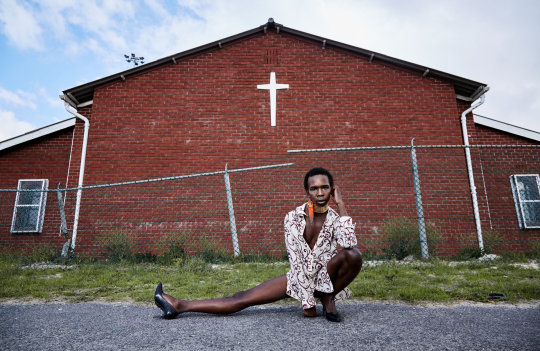
^Mandisi Dolle Phika, 27, asked to be photographed by a church, an important place to her family but a place where she says she has faced anti-queer bias. At Catholic school, she remembers, “I once overheard a conversation where it was said I have a 'gay-demon.’” Now studying LGBTQI political leadership, she believes in “a colorful God” that “celebrates diversity in all its manifestations.” (photo by Lee-Ann Olwage)
Discrimination is a part of everyday life for queer people in the townships, especially at taxi stands, churches and schools. In the Western Cape alone, a 2016 survey of 112 LGBT participants age 16 to 24 by Love Not Hate, a national campaign addressing anti-gay hate crimes, found that about two-thirds of LGBT people between the ages of 16 to 24 reported experiencing discrimination at school. Reliable statistics are rare, because queer people in townships often choose not to report harassment or violence out of fears for their safety and distrust of local law enforcement.

^ Unathi Ferguson, left, was outed by a teacher in 11th grade but eventually saw the moment as a chance to “embark on a journey to sanity and complete acceptance [about] who I was.” Shakira Mabika, right, emigrated from Zimbabwe to South Africa in 2013. Olwage says the women told her they had forged “a newfound sisterhood.” (photo by Lee-Ann Olwage)
Black queer people here, as in many other parts of the world, also struggle to be understood by their health care system. Some studies have found that LGBT patients have been subjected to discrimination, with health care providers refusing them care or doling out moral judgment. Long lines of people waiting for free treatment at clinics or state hospitals in impoverished areas can lead to a lack of privacy for patients. As a result, many avoid medical care or receive poor care.
But the picture doesn’t have to be bleak. “Living in a township has taught me to be strong and strive. I have dealt with the stigma and hate, and now am stronger,” said Liyana Arianna Madikizela, a 17-year-old who posed for photographs.
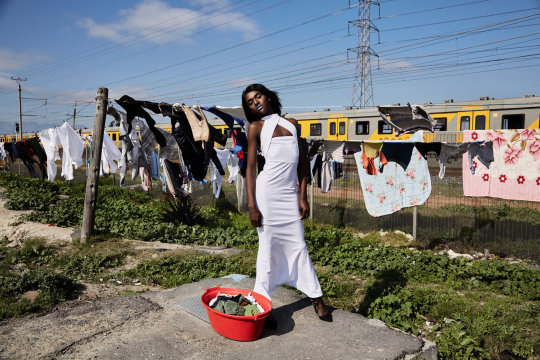
^Liyana Arianna Madikizela, 17, is a drag artist from the township of Kayamandi. She poses near a string of drying clothes to challenge traditional gender roles. “I realized I was different when I didn’t want to do the stereotypical manly duties,” she says. “I was always keen to do house duties such as washing dishes, doing the laundry, cleaning the house and cooking.” (photo by Lee-Ann Olwage)
Madikizela embodies the strength and resilience the drag queens have shown in the face of injustice and oppression. “I want to become the role model I never saw in the streets of Kayamandi,” she said. “Someone who is unapologetically gender non-conforming and who navigates their lives against all the hostile odds of living in the township.”
Lee-Ann Olwage is a South Africa-based photographer. Sasha Ingber is a Washington, D.C., freelance writer. Belinda Qaqamba Ka-Fassie, a drag artist and advocate, collaborated with Olwage on this project.
2K notes
·
View notes
Link
Voice pitch is another method of indicating gender. Jessica a reality TV contestant was infamous for using a childlike voice around men as a means of performing femininity.
Multiple studies have been done on voices and how certain pitches are perceived as being more attractive than others. In women a higher pitched voice is frequently found to be more attractive than a lower pitch.
https://www.researchgate.net/profile/Lisa_Debruine2/publication/5309927_The_role_of_femininity_and_averageness_in_aesthetic_judgments_of_women's_voices/links/0f31752d65f36d1d61000000.pdf
https://journals.plos.org/plosone/article?id=10.1371/journal.pone.0032719
0 notes
Link
Meg Allen is a San Francisco Bay Area photographer whose work explores the butch aesthetic, identity and the presentation of female masculinity.
216 notes
·
View notes
Text
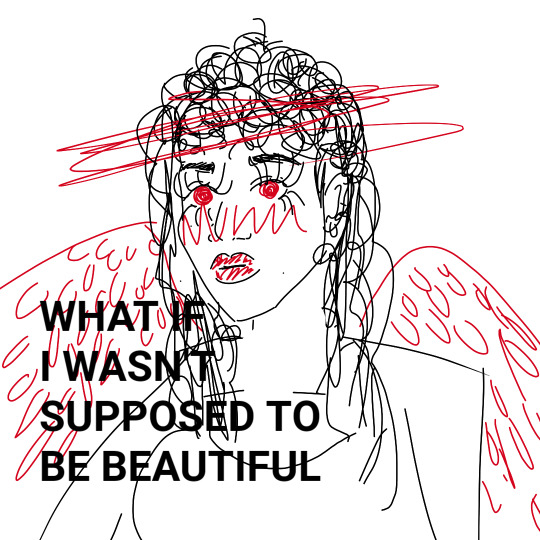

THE UGLIEST GIRL IN THE WORLD
"What If I Wasn't Supposed To Be Beautiful".
"What If I Was Supposed To Be So Much More".
2019
commissions + donate - shops - more
969 notes
·
View notes
Photo

https://afropunk.com/2016/05/feature-photographer-lynette-luna-uses-men-with-flowers-series-to-depict-softer-side-of-masculinity/
Increased understanding of how gender functions in society and through imagery has allowed for greater exploration into the performance of gender. Sensitivity can be masculine.
0 notes
Text

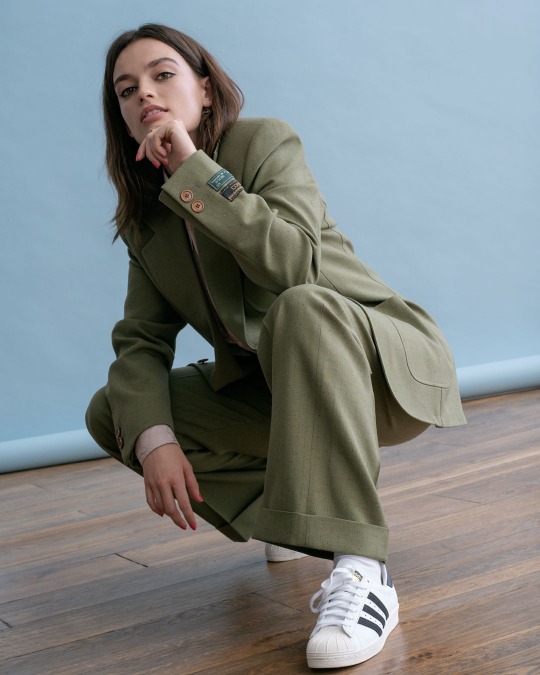
Girls don’t want boys.Girls want Emma Mackey in a suit.
795 notes
·
View notes
Photo
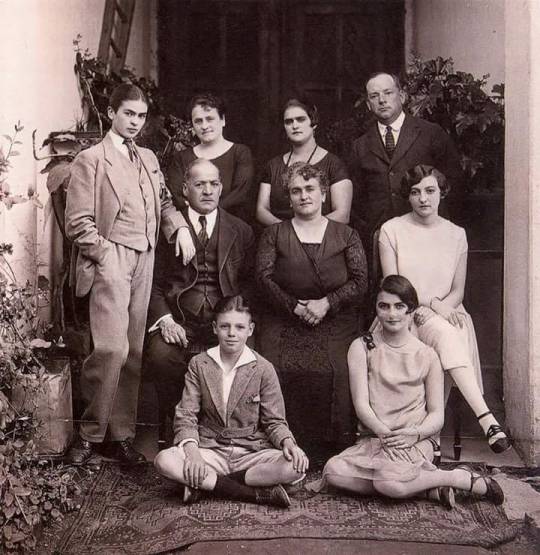
Frida Kahlo (wearing a menswear suit) in her family portrait, 1924.
26K notes
·
View notes
Video
youtube
James Charles is a controversial figure for a variety of valid reasons, but his primary claim to fame is being the first male ambassador for the makeup brand Covergirl. He often uses more stereotypically feminine manners of speech, but still identifies his gender as male. While many of his methods lay outside of what is generally considered masculine performances of gender his feeling of his gender is different. In this we can see how gender can be performed in a variety of ways.
0 notes
Quote
The idea is that in interaction, people do things to show similarity and difference with other people (present or not) and thus create categories with those people. A second tactic is along the dimensions of authentication and denaturalization, in which interaction and language are used to authenticate someone's 'natural' identity, or to mark a performative gender action as somehow not authenticate (to 'denaturalize' it.) Finally, there is authorization and illegitimation, which refer to the ways societies, cultures, and institutions allow certain categories of identity, and allow certain people into those categories.
Scott F. Kiesling
0 notes
Photo
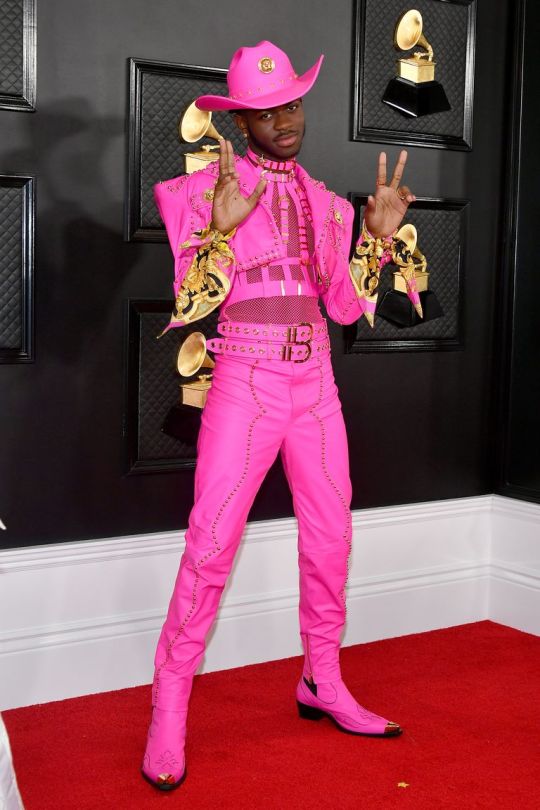
https://www.elle.com/fashion/a30668646/grammys-2020-pink-suit-trend/
As understanding of how gender functions in society has expanded more room has been created for exploration. Lil x Nas is a rapper, something that has socially always been hyper-masculine. As a successful gay rapper his position allows him to push boundaries. Pink is considered a feminine color and cowboys are often symbolic of masculinity but Lil x Was wears an entire hot pink cowboy suit. Several other rappers were seen wearing pink suits at the same event as Lil x Nas.
0 notes
Photo

https://www.elitedaily.com/p/the-reason-billie-eilish-wears-baggy-clothes-is-actually-really-upsetting-18734053
Billie Eilish is a teen pop icon whose choice in clothing often comes up as a topic when discussing her. Eilish opts for baggier clothing and traditionally more masculine looks. She thwarts sartorial femininity expanding what can be considered feminine in gender.
0 notes
Photo


https://twistedsifter.com/2012/01/men-in-pin-up-poses/
Men-Ups is a series of photos taken by photographer Rion Sabean. It’s relevant to this project due to the nature of the photos. The men are featured in stereotypically feminine photo poses, taking from the pin-up genre. However, their masculine gender is maintained through a variety of things. Viewers are meant to understand the ridiculousness of the poses, while also comprehending that the men featured maintain their masculinity despite the poses, through elements provided in the pictures such as weights or a shovel.
0 notes
